MTG: Friendly Planeswalkers
There’s a lot of Magic: The Gathering that uses mechanics to express theme. Theme is really important, since being able to see card entities as creatures that relate to one another, enchantments that relate to greater rules, artifacts that have a material existence and lands that can be used or expended is a big part of how you manage the mental load of all the game parts happening at once. This is going to be a quick introduction, then we’re going to do a list, so buckle up.
Continue Reading →MTG: Dinobots (Not The Transformers) Commanders!
Hello, Wizards of the Coast employees. This blog post is going to feature custom cards and I know you’re not allowed to look at those. So, please, go elsewhere, sorry!
Magic The Gathering? In Smooch month? is this going to be about shipping? Is this going to be about Nissa and Chandra, and the War Of the Spark: Forsaken?
No.
Because I don’t really care about that.
I mean I don’t have the book; I don’t plan on buying the book; the book was handled so badly that Wizards of the Coast apologised for it, and there are rundowns on how the writing is bad (even setting aside the subject matter) and ways that the Nissa/Chandra romance was specifically handled, and really, you don’t need someone who hasn’t got the book, and has no interest in reading it, to go over it.
Instead, I want to talk about a shipping pair I learned about from Twitter, and has basically no basis in actual canon but I don’t care.
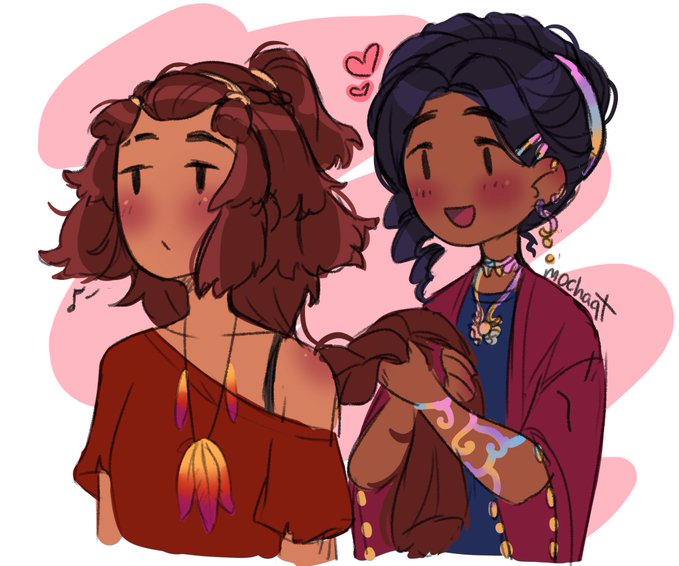
MTG: Stop Designing White Counterspells
Seriously. That’s it. Those four words.
Alright, fine.
White in the Throne of Eldraine standard period, isn’t great! It’s not very strong and uh, also in Commander, white’s not very strong, and so the Content Creation mill has kicked in and presented the brilliant idea of White Bad. The Magic community, being the reasonable well-rounded and thoughtful group of people they are have immediately leapt face-first into a wall.
We’re not good with handling conversations that need words.
One of the places that people have decided this needs addressing is by saying that white (which is the WORST COLOUR and ALWAYS SUCKS) needs to have CARD DRAW and RAMP and COUNTERSPELLS. Now, I’ve some sympathy to the problems presented before (and I’ve written about it), but the last one bothers me, because it’s the same, simple, looping argument. It’s very catastrophised and gets to involve things like ‘Maro doesn’t know what he’s talking about’ and ‘Maro hates white,’ which… yeah. Do I bust out the statistics and the historical context to address these arguments? Sometimes – it’s just it’s work, and because it’s social media, that argument drifts away and I have to go re-make it an hour later. I want it all centralised and convenient.
Here, then is my thoughts on why we should stop designing custom white counterspells. If you’re a Wizards employee, current or former, rejoice, because I’m not going to show any custom designs here or even talk about them in depth. I’m just going to go over the idea of white getting counterspells at all.
And first, some context!
Continue Reading →MTG: Crumby Engine
Throne of Eldraine really has a mark on its name as being a set that led to one of the shortened banning spans. It’s really rough, because as bad as Oko is as both a character presence and the impact he had on standard, there are some cards in Throne of Eldraine I didn’t expect to like, and even missed wholesale that have crept up to be some of my favourite kinds of card.
I do like playing around with uncommon engine cards, and one of the sadder things to me about small sets or sets that do poorly is how uncommon engines often have to make do with only the cards in their set and that’s it. This isn’t engines like you see in Innistrad where we’re absolutely going to see more werewolves if we go back there, it’s the sets that failed to catch an audience. Sometimes an engine gets support outside of its block and still isn’t good enough (hi there, [mtg_card]Earthshaker[/mtg_card]), and sometimes the engine card is great but there isn’t adequate support for it in the format (hi there, [mtg_card]Sylvan Echoes[/mtg_card]).
And yes, I have tried making all of these work.
It’s a long path we’ve walked to get here, but well, you don’t come to my blog if you’re not willing to follow a [mtg_card]trail of crumbs[/mtg_card].
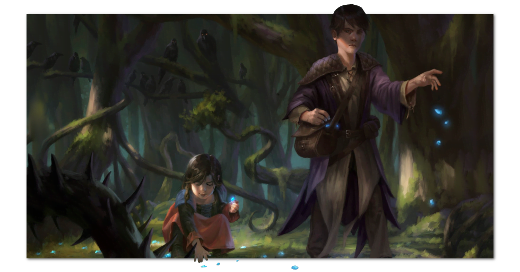
I don’t doubt we’ll see Eldraine again, but I suspect it’ll be a while and I suspect that while means that for now, Trail of Crumbs has to do all the work it can with what it’s got. Jund and Golgari Food has been tearing up standard for a while now, and it’s also a deck where you can make a meaningfully cheap version and don’t lose out on how the deck works. I even lashed out and bought myself some Lilianas and Vraskas and have a neat little standard two-coloured version of this deck (thank you Patrons).
Decemberween: Custom Card Making
I participate on the Custom Magic Subreddit, a place where amateur designers come together to make cards for Magic: The Gathering, and it is a place where, overall, people get the colour pie wrong. But that’s okay, because we’re all amateurs and we’re all having fun.
Now, if you look through my history you’ll see that largely, I am pretty negative, but I have seen cards that I liked and wanted people to see, and so, that’s what this post is about. I thought I’d get all the cards I liked in a year and put them in one master post, but uhhh, so that was a bad idea for a number of reasons. First, Reddit doesn’t archive your personal upvoting history that far (it only shows the most recent 1,000, it seems), and second, I have liked way more than ten or twenty cards this year, and third, some of the people who made those cards have deleted their accounts, which makes it really hard to properly credit them.
Hey, Wizards employees! Stop reading! This is going to start showing custom magic cards, as unsolicited designs! Thank you! I don’t want you or me getting in trouble!
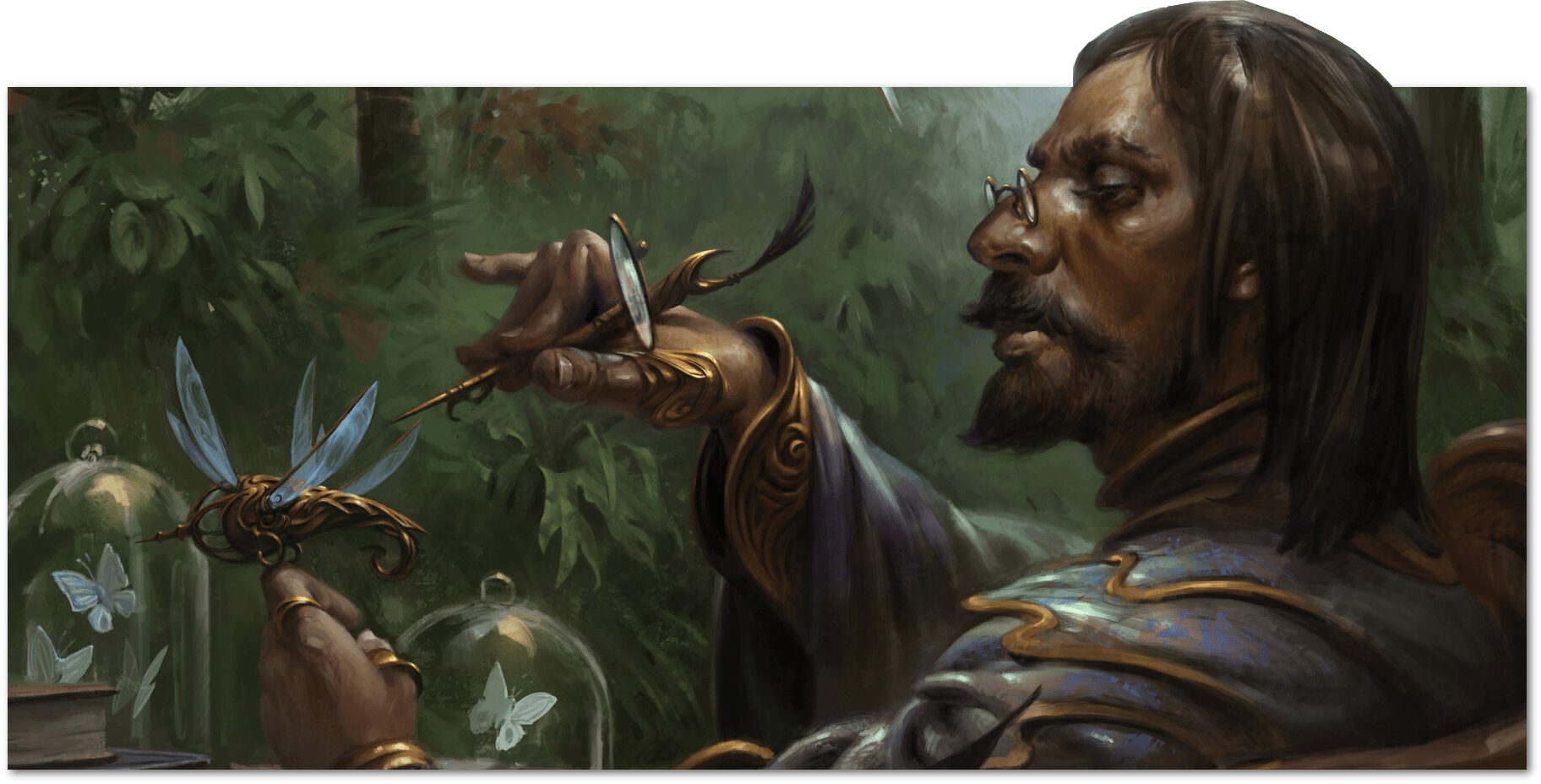
Decemberween: MTG Cards I liked!
I started this year pretty burned out on writing about Magic: The Gathering, what with the heavy narrative focus on the importance of Nicol Bolas, and what I saw as at least another half year defined by that story and the ongoing pressure of Teferi. I wasn’t having fun! It wasn’t cool! I found myself getting annoyed at how much work it was to pump out Magic articles that weren’t very shallow, and so, I stopped.
Now, this has not been a good year for Magic: The Gathering, overall, I don’t think. It’s probably sold fine, but it’s just been one of those years with a lot of rake-step moments. Bannings in standard, data breaches, story controversies, another new format being created and handled weirdly, continued problems with Brawl, players just being the worst and oh look, another Teferi planeswalker that we’re all going to be very glad to see rotate out and also, Throne of Eldraine bringing
interesting challenges.
But while I haven’t been writing about it that much I have been playing Magic quite a bit, and I realised there was a whole fistful of cards from this past year that I really liked and I wanted to shout out about them. Hey, if you’re a casual Magic player, these cards are worth grabbing, especially because they’re really cheap.
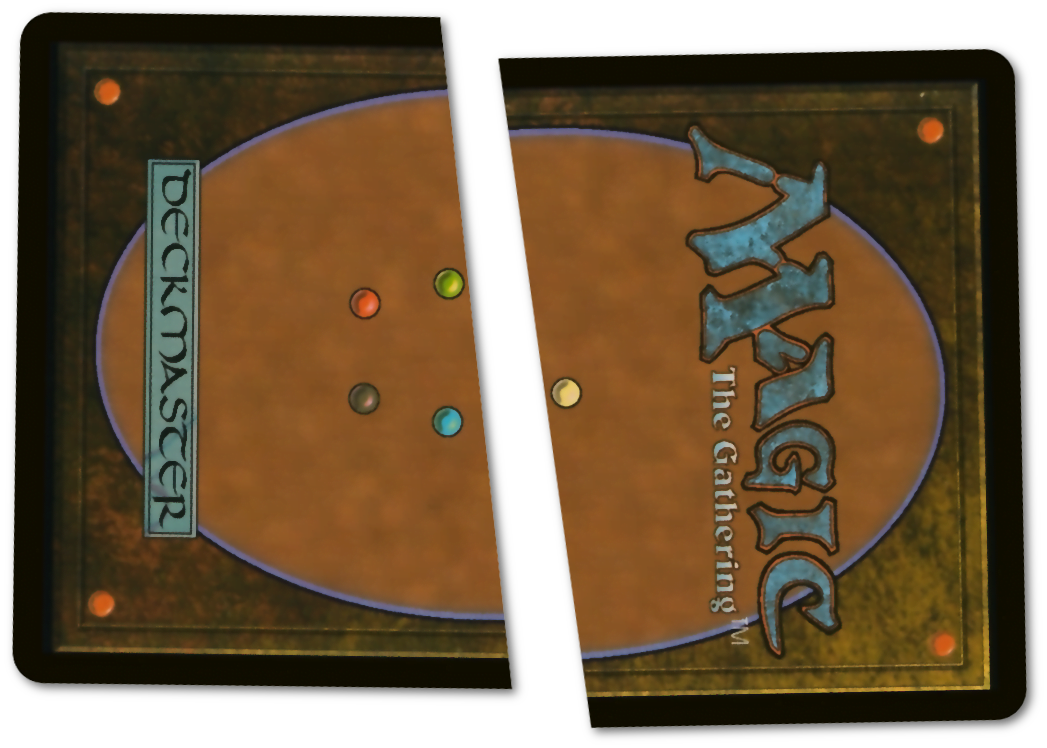
MTG: The End Of Okotober
Well, there have been stannings in bandard again, and with it comes a new round of discourse. Discourse means arguments, arguments mean redditors mouthing off, and since I don’t like getting into arguments on reddit, I thought, hey, why don’t I have that beef here, on my blog, where nobody has the right to response, because the last thing in the world I give a damn about is arguing with Redditors who don’t appreciate my expertise.
Seriously, Reddit is extremely bad for these conversations.
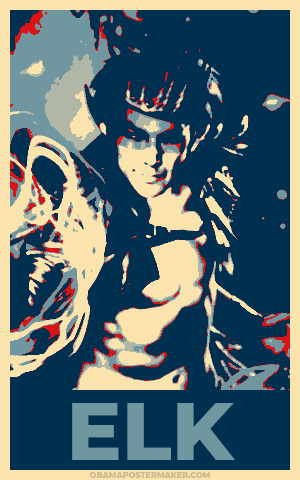
Okay, so what happened today: three cards were banned, which means that they join Field of the Dead creating an environment where four cards are banned, which is a bit more than normal. The three cards are Oko, Thief of Crowns, Once Upon a Time and Veil of Summer. Now, personally, I’m completely fine with seeing these cards go – but I wasn’t playing standard, because of these cards, and because I didn’t want to deal with ever seeing it when I went to play standard.
Now, historically speaking, Standard is a format that doesn’t tend to get bannings. There have been long periods, like, years at a time, when there weren’t any cards banned in standard. Cards like Umezawa’s Jitte weren’t banned in standard, despite the oppressive effect they had on decks at the time. Comparatively speaking, this is also a pretty fast one – Oko was legal for only a few months. It wasn’t one of the fastest bannings, but it sure was a big one.
What this mostly reminds me of is almost a mulligan on Darksteel’s bannings. Back in 2005, when the bannings came for standard’s beast, the Ravager Affinity deck, there were two sentiments Aaron Forsythe expressed: One, that merely banning Skullclamp and hoping that would fix things hadn’t been enough, and two, that they didn’t just do the bannings to fix the environment, but to make it very clear to anyone who saw it, that the deck they hated wasn’t just weaker, but it was dead. The turn of phrase Forsythe used has stuck with me; he referred to it as Slaying the Dragon.
Did Once Upon A Time need to go? Despite people pontificating about ‘linear play focus’ and ‘the london mulligan is the problem,’ there was probably still room to allow green decks the chance to push into their decks. If Once Upon A Time showed up in another broken deck, odds are good it wouldn’t be as oppressive as Oko, after all, and it could get gone in the next round. Same with Veil of Summer; it was a great tool for stopping blue and black decks that wanted to try and interrupt a green deck. If there was no powerful green deck, or blue and black decks weren’t liable to use tools that Veil of Summer stopped, hypothetically, Veil would rotate out. It wasn’t as important to protect an Oko and all.
But instead, all three of them went, and then some folk wanted to complain about Nissa, Who Shakes The World, suggesting that to some folk, this dragon wasn’t dead enough, and there’s a noisome voice that this problem is linked to how overpowered green is. Also, there’s people talking about how ‘bannings in standard twice in a year is a sign of a broken game,’ or ‘play design need to be fired.’ I don’t countenance these much, and I’m not all that bothered by these bannings and any potential impact they may have compared to older formats.
Why?
Three reasons.
Information has sped up. Right now, there are more people playing Magic in more interconnected ways in more tournaments than ever. Formats are going to get solved more aggressively than they used to. Tech gets discovered and tested and it’s less a question of if someone sees an interaction in the game space as when someone deduces the best way to deal with it. It’s a sad space for the rogue builder, but broadly speaking it feels to me like Magic has transcended the time and space when you could surprise the game at large even if you could outfox one day’s opponents.
This also means Wizards have access to a lot more information to make judgments. Felidar Guardian got nixed after seeing its tournament presence, for example, rather than having to try and make a called shot on something that could be fun and unimpressive or could be oppressive for three months.
Release speed have sped up. Wizards used to print more cards back in the day per year (sets were bigger), but those sets were packed full of lots of cards that you would not remember nor care about. Not even casual players are running around eager to buy up Spitting Gournas. Lots of formats were full of filler cards. Sets have gotten smaller, but they’ve also gotten more cards worth playing, across all rarities (see people complaining about commons being under-represented in tournament decks here, no I don’t care, shut up and go away).
This means there’s more chance that a single card released is going to be a problem, and that problem is just going to kinda… hang around more if wizards expect us to fix it ourselves (as above).
Wizards have more tools for fixing things. This is the big one. There have been times when standard has been sicker, but sick in a variety of different ways. Onslaught through Kamigawa mirrodin was not a fun standard to get involved in because there were four or five decks that you simply didn’t have a prayer against with anything but one of the other four or five. There was variety, but the play experience was full of fewer decisions and there was a lot more of the game contingent on whether you or they got their busted cards. Tooth and Nail and Affinity were two decks, but they were both kinda ignoring you, even if there was no single card that overwhelmed standard.
But now, Wizards are in a position to make regular changes and updates to standard to try and address things, and as they showed today, they slew a dragon. Maybe standard can be cool now – I don’t know. I’m hoping so, but we’ll have to find out.
Once upon a time, Jamie Wakefield pointed out that by not banning Masticore, Wizards effectively banned every card that wasn’t as good as Masticore; that Flametongue Kavu being as good and ubiquitous as it was made every other 4-toughness creature not worth playing, because answers to it were too efficient. People rent their clothes about the Ravenous Chupacabra, but lo and behold, that wasn’t the thing that ruined standard.
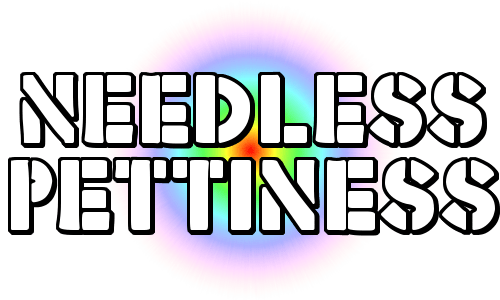
One final point is that all the people complaining about ‘overpowered green’ seem to have neatly forgotten that Oko and Hydroid Krasis aren’t just green cards. I did see the hot take that because the Krasis was expensive, it was effectively a ‘mono green card.’ I’d like to call that person out and say: you’re a ninny.
In general, while people are crying doom and gloom and insulting – literally – Wizards R&D for making the best decisions they can to address the best decisions they were able to make earlier, and where we have old men who like Ancestral Recall hollering at clouds because Planeswalkers ruin magic, I’m just happy to see that the format was addressed, and they’re talking about ways to make these announcements and responses more fluid.
Thumbs up, here’s hoping the next round of standard is a fun one.
Atla Palani Says Trans Rights
This may be the most complex deck skeleton I have ever considered trying to make.
Continue Reading →MTG: Rally Vincente
Time to time, Frank Karsten will release lists of combos that exist or have been made possibly by new additions to an environment. In Modern Horizons, he showed two that I really like: [mtg_card]Vesperlark[/mtg_card] and [mtg_card]Phantasmal Image[/mtg_card] allow for infinite sacrifices and so does [mtg_card]Saffi Eriksdotter[/mtg_card] and [mtg_card]Renegade Rallier[/mtg_card]. He forwarded the Saffi/Rallier combo with [mtg_card]Altar of Dementia[/mtg_card], as a sacrifice outlet that immediately eats your opponent’s whole library.
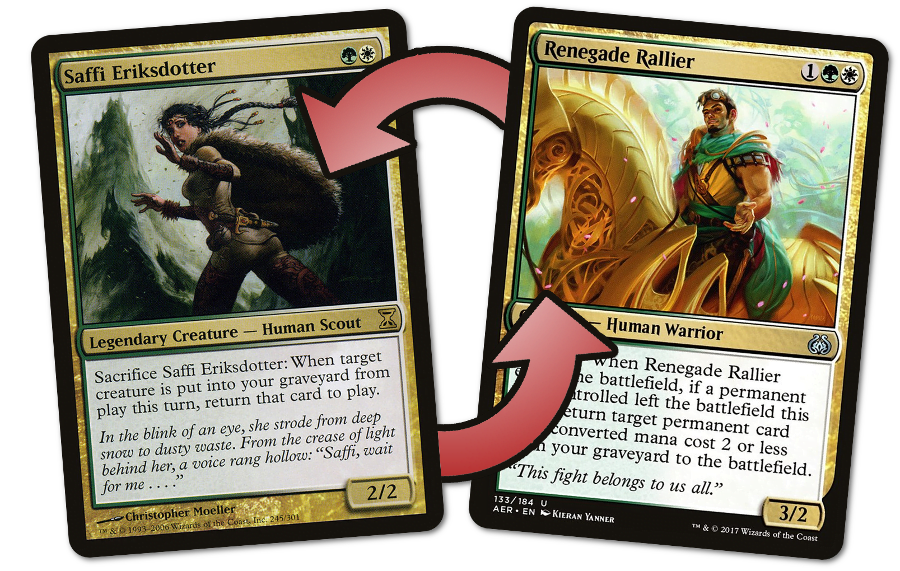
It’s that latter one is really interesting to me because it’s in the same colours, all the cards in question are pretty aggressively costed, and they’re cheap to play with.
What can we do with them?
Let’s break it down into three basic bits:
Muruganda!
Hey, if you’re a Wizards of the Coast employee, you’re not in a position to read this article. There’s a custom card or two in here, and I know you’re not allowed to look a those. Don’t worry, I don’t expect it’s anything you haven’t come up with on your own.
MTG: Blockness in Ravnica 3: The Secret of The Ooze
When making my Kamigawa remake, I used the term blockness to describe the way that a single card related to the time and place it was printed. The idea, as much as I described it, is that you can consider a card in terms of how much it belongs to the specific block and environment into which it was printed; that is, for some cards there just aren’t that many opportunities something like that card can be printed.
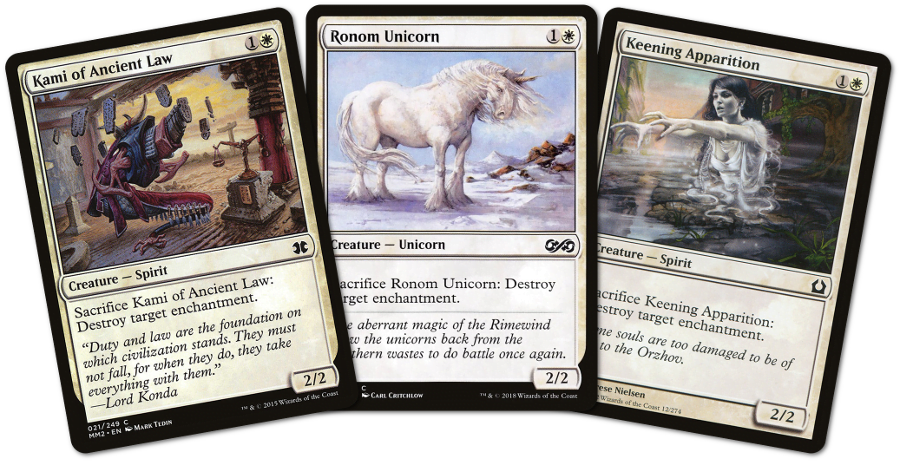
Now, sometimes it’s the flavour of the card, but usually blockness is tied to mechanics. You can always just re-flavour a card with different art, name, and creature types, like we saw in the the beautifully basic Kami of Ancient Law. In Kamigawa block, the Kami of Ancient law’s spirit creature type meant it interacted with other creatures and spells in the set. When Ronom Unicorn was printed slightly over a year later, it had no particular impact, and then when Keening Apparition was printed, another six years later, there was no particular relationship between the card and its environment. Wizards actually has their own take on this idea – sometimes you’ll hear a card referred to as Core-Set Ready. Core-Set ready cards are cards that can be put into a core set, sets made up of less complex cards that are designed to be approachable.
The fact is most cards don’t get reprinted – just sheer numbers work against it – and most mechanics are shallow enough that there’s only a small number of cards they can be used to make. Some set mechanics really aren’t going to have much chance to ever be seen again, so when it comes to some keyword mechanics like Mentor or Exploit or Living Weapon, the best cards of that mechanic are really the best cards we’re likely to ever see. It’s kind of a bummer, because you see a lot of those cards

When I first discussed this, I complained that the (then recent) Guilds of Ravnica mechanic for the Golgari guild was extremely lacking in blockness – that of those cards, literally all of them could be printed in basically any given set; the ability word of Undergrowth was so generic and so flexible it could have been printed anywhere. I didn’t think so little of the other mechanics in the set, mind you, and I have no idea how well these mechanics play with one another in limited.
Ravnica is a weird place. It’s weird because it’s a place that wants, as much as possible, to have continuity between three blocks and more, and hypothetically to make cards that at least supposedly can work with one another. There have been hits and misses on that front; Batallion cards and Mentor cards work just fine, and Batallion is one of those mechanics you can print without putting the keyword on it, meaning there’s a Batallion card in War Of The Spark. At the same time, lots of Golgari decks can get value out of a few Dredge cards, even if it’s just one-ofs like Dakmor Salvage.
I feel that it’s kind of hard for the Golgari to ever escape the fact that their first mechanic is mathematically one of the most powerful ever printed; of the fourteen dredge cards, about eleven of them have seen serious play. By comparison, Scavenge, the next Golgari mechanic, kinda doesn’t actually have any cards that are worth much of anything at all. Varolz, the Scar-Striped has his place in CEDH, but other than that, there’s not a single Scavenge card I have seen see play outside of oddball formats like Canlander. It wasn’t a mechanic exciting enough to see return, and it’s tied to the Golgari, and that meant there was a whole block of Golgari cards that don’t really matter much to a Golgari deck. Then we get Undergrowth, which doesn’t feel like it needed to be a keyword at all.
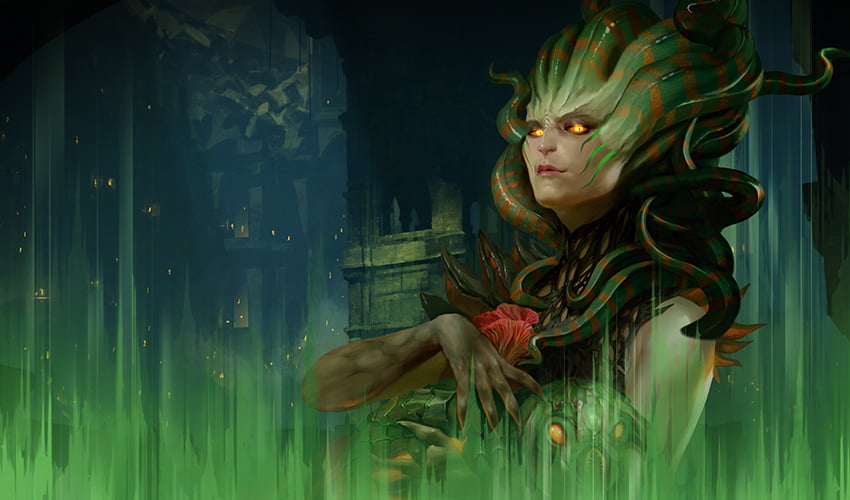
It’s a challenge I don’t imagine it’s fun to try and deal with. Particularly because Ravnica blocks are so tight on space, the limited environments are so bound around the challenges of synergy, of wending each set’s colour pairs so they draft well together, and making those mechanics fun and interesting without becoming a Lorwyn-style overcomplicated turbo-mess.
And the thing is, I kind of wonder if part of what’s going to haunt Ravnica, the plane, is its own success. It’s beloved, in flavour terms; it’s what finally seems to have broken the boundary between Dungeons & Dragons and Magic: The Gathering in a big way, and every Ravnica set seems to bring with it a lot of energy and hype, because it is one of the most popular settings for the game.
It is a setting where each mechanic demands high blockness, but low complexity; it wants cards that can only come from Ravnica, and it wants them to have mechanics that are not confusing and alienating.
MTG: Jeskai Catgirls
Okay, Modern is a silly place. This is not going to be about a cutting edge deck. This is the kind of deck I like to write about and play, because it’s not trying to be about playing in a specific metagame environment, about being in a tournament space. It’s a combo deck, but it looks a bit like a control deck, and it uses an interaction that’s probably too slow for standard, but also gets to do stuff I tend to enjoy – flickering permanents and making memes.
Anyway, here’s the basic gimmick.
There’s this card, Felidar Guardian. There’s this other card, Saheeli Rai. Together they form a combo that generates an infinite number of hasty artifact cats, or rather, an arbitary large number of hasty artifact cats, so you can stop when you want. It differs from a lot of combos in that the cards are actually good on their own, with Saheeli being a planeswalker that scries through your deck to find things, and the Felidar Guardian resetting a lot of possible permanents.
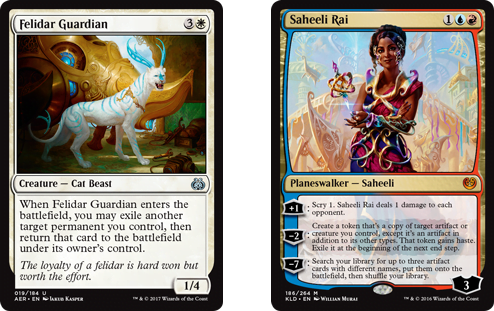
Now, I like Felidar Guardian decks, because I like flickering things. I like when my value creatures give me more value, and I’ve liked that since [mtg_card]Astral Slide[/mtg_card], a deck that isn’t actually good anywhere any more, but let’s not get bogged down in that. The thing with this combo, known as Cat Lady for a while, was that it was pretty powerful in Standard (so much so it got a sort-of emergency ban?), and my love of durdling and flickering creatures is kind of weak when compared to ‘just winning the god damn game out of nowhere.’
Also, flickering creatures with the Felidar Guardian is fine, but also not particularly impressive these days. You want stuff that’s already on the field with the Guardian around, and flickering wants to be cheap, and so it’s not good for recurring on the battlefield, and so on. Still, War of the Spark gave us a bunch of planeswalkers that tick down and you can use the Guardian to flicker a bunch of them. Funnily enough, in these colours, there are a few really good Planeswalkers for this, and they seem to all be girls.
And thus, from Cat Lady, we now have:
[d title=”Modern Jeskai Catgirls, October 2019″ style=”embedded”]Creatures
4 Felidar Guardian
4 Wall of Omens
Planeswalkers
1 Chandra, Acolyte of Flame
4 Saheeli Rai
3 Narset, Parter of Veils
1 The Wanderer
Spells
4 Lightning Helix
4 Lightning Bolt
4 Remand
4 Sleight of Hand
4 Hallowed Fountain
4 Serum Visions
Lands
4 Sacred Foundry
2 Glacial Fortress
2 Clifftop Retreat
4 Steam Vents
2 Plains
2 Island
1 Mountain
2 Sulfur Falls[/d]
This deck could be improved massively with the addition of [mtg_card]Snapcaster Mage[/mtg_card], because at its root it is a 1-2 mana spell based control deck that wants to dig through a deck and win reasonably quickly. [mtg_card]Chandra, Acolyte of Flame[/mtg_card] is a pretty decent kinda-Snapcaster who has supplied some games with an extra few points of damage, but it’s very clear to me the difference between 3 mana and 2.
You make lands and planeswalkers, protect yourself, slow your opponent down, dig for cards, kill threats, then find Saheeli or a Guardian or whichever you don’t already have, then win the game immediately.
It’s not great, but it is fun!
MTG: Dancing In The Cinders
Is it something about Aristocrats decks that get me to come out and play? Is that what pulls me into Standard? I feel dirty, like somehow it’s just the interaction between some junk drawer creature and a junk lord and suddenly I’m just an easy get for a standard environment.
Anyway, I’ve been playing Magic: The Gathering a little more, and rather than hanging around in the silly waters of Commander 1v1 (a format where I mostly goldfish), I’ve been playing Standard and Modern (and we’ll get to that), based on throwing together a reasonably cheap deck. Right now is one of the best times to get a standard deck with a good mana base together, because there’s a standard-legal Ravnica set, pulling the cost on Ravnica duals down to nearly a buck each on MTGO.
[d title=”Mardu Aristocrats, September 2019″ style=”embedded”]Creatures
4 Hunted Witness
4 Grim Initiate
4 Tithe Taker
4 Priest of Forgotten Gods
4 Cruel Celebrant
4 Mayhem Devil
2 Imperious Oligarch
2 Judith, The Scourge Diva
2 Midnight Reaper
1 Ministrant of Obligation
1 Demon of Catastrophes
Spells
4 Spark Harvest
Lands
4 Blood Crypt
4 Dragonskull Summit
4 Godless Shrine
4 Isolated Chapel
4 Sacred Foundry
4 Clifftop Retreat
[/d]
The basic anatomy of this kind of deck, known colloquially as an Aristocrats deck is threefold; you want cards that don’t mind being sacrificed (‘food’), you want things that can sacrifice cards for benefit (‘feeders’), and things that react to the interactions between the first two (‘zookeepers’). It’s a neat little ecosystem of a deck and part of what I like about it is how it makes a lot of creatures that are, at best, kinda cheap and durdly, into something your opponent has to spend their cards on, and even then, they’re not guaranteed to get ahead when that happens.
This deck is by no means what you’d call ‘good’ – the last time I did this I had [mtg_card]Zulaport Cutthroat[/mtg_card], and let me tell you, [mtg_card]Cruel Celebrant[/mtg_card] is no Cutthroat. Or maybe I’m just sour about mana in general. There’s also the way that [mtg_card]Mayhem Devil[/mtg_card] works, dealing damage wherever you like but also crucially making that damage require sacrifice. There are draws however where you get some mix like a [mtg_card]Hunted Witness[/mtg_card] into a [mtg_card]Priest of Forgotten Gods[/mtg_card] into [mtg_card]Cruel Celebrant[/mtg_card] and [mtg_card]Grim Initiate[/mtg_card], and you blow your opponent’s board up, draw some cards and then drop another Priest of the Forgotten Gods, and then they cheer and people pick you up and lead you around the room and you’re just the best.
And those games are pretty fun, especially in the low-stakes casual standard room where you are going to face things like Treefolk Tribal and Ladies Facing Left. Still, there are plenty of times you draw a hand and you’re looking at a fistful of 1/1s and a land, or 4 mayhem devils and three lands and know you’re probably not winning with that. It doesn’t mulligan great either – you kind of need a mix of your pieces, and every card you start down loses you a piece, and a chance at a better piece.
Nonetheless, I really enjoy this deck and it’s pretty rotation proof at the moment. I don’t know what’s going to add to it in the upcoming sets, but for now, it’s a fun little unit. I need to develop it a sideboard, though, so I can play it casually in the Tournament room, rather than hang in the much more variable space of the casual room.
Work In Progress: Combo Shirts
Okay, first things first, here’s a design.
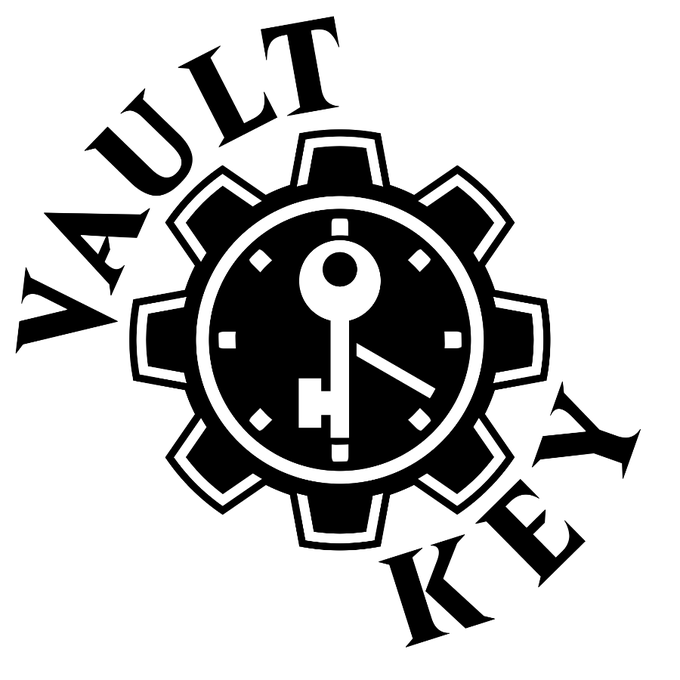
Do you know what this is? Magic: the Gathering fans, people who play in eternal formats, may recognise it. It’s a two-word reference to a combo of two cards that work together to let you take infinite turns, and therefore, most of the time, just automatically win the game in some way or another. It’s a powerful combo, and in the formats it’s in, it’s kinda a ‘good’ combo. It can be a total blowout – you can literally just start the game and in those formats, draw the right combination of cards that mean your opponent never ever gets a turn.
Anyway, this design is part of an idea I had where I thought about making a set of shirt or sticker logos that represent prominent two-card combos from Magic: The Gathering. What I did was ask the public if they had any ideas, and I got some… and they were pretty cool!
I hadn’t really framed the question clearly, though! I got a lot of cool combos people used in their decks, things they loved to do. There’s a neat combo with [mtg_card]Basalt Monolith[/mtg_card] and [mtg_card]Wake Thrasher[/mtg_card], for example!
I didn’t get advice or suggestions for what I wanted – but it’s okay. Instead, I got to listen to my friends, who were cool and neat.
The Double Nickel
If you google the term ‘the double nickel,’ you’ll usually find something about trucker slang, from the CB radio days. It refers to 55 miles an hour, two fives next to each other. More obscurely, however, is it’s a term from Magic: The Gathering tournament scenes, based out of New York.
If you like Mike Flores’ writing, this ten year old article from Flores explains the whole thing – but it is a bit of a ‘crystal in time’ moment. It’s from back when there was really one Magic web show, called The Magic Show, back when I argued against Youtube as a platform for Magic content because it simply wasn’t a viable format for me, in Australia with cheap, poor internet. It’s also a bit rambling and full of Flores’ personal affect, which I of all people would be an asshole to complain about, but if you’re only here because of game design, and not here because you’re a massive magic nerd who cares about history of the game, let alone the specifics of the game that were history ten years ago.
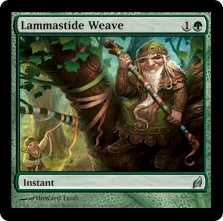
The basic idea is the double nickel is you do two iterations of a five-pile shuffle, which, when dealing with a number of cards divisible by five (forty or sixty, as in Magic), you will get back to where you started. This shuffling method is a pretty reliable cheat – used by one Mike Long in a famous cheating incident involving a card called [mtg_card]Howling Wolf[/mtg_card]. And now I’m getting bogged down in the specifics of that game.
Anyway, the thing to know about this is one of the reasons why a lot of my games use these deliberately inconvenient numbers. If you’ve ever played LFG, you might notice there are 23 character cards, so a card always winds up in the graveyard when the cards are dealt out to the players. This is also true in Senpai Notice Me, where part of the setup is to make sure that there’s a card discarded from the game, and so there’s not perfect information about what’s in it.
The double nickel also is something you can use in the setup of a game deliberately. In Pandemic there’s a set of outbreak cards that get shuffled into sub-decks, and so to in Goodcritters, to make sure that there’s an end to the game coming but you can’t be sure of how it arrives. We used this tech in Foxtail, too, to make sure that the end game could be set up without necessarily making it guaranteed.
Game Pile: War of The Spark!
I Like: Benjamin Wheeler
I have a really sour love of Canadian Highlander. It’s a really interesting format whose first impressions in the online space were presented in a way that I felt was really dickish and condescending. Yet, thanks to the neverending presence of a bunch of very entertaining professional comedians playing the game, I’ve come to really enjoy the format (though not enough to investigate playing it myself).
One thing that’s made me really appreciate the game is one of the North 100 podcast’s hosts, or rather, the newest host, Benjamin Wheeler.
Canadian Highlander is a format where duals and fetches run rampant and that makes it economically unfeasible. Ben has talked about budget in the paper format, but also shows ways to make it accessible on MTGO. It’s cheaper, and also, because we get a one-sided take on very thoughtful engagement with the game, Ben digs deep into complex combo lines.
I like these streams; they’re long, Ben’s taste in music amuses me, and occasionally you get Keifer Content, where his husband like, vapes the screen full of fog. It’s fun, it’s funny, and technically, queer MTG Media, so hey, it counts this month.
MTG: Word Counts
Hey, Wizards Employees! There’s a custom card in this post! It’s just a bunch of existing keywords on a blank field! I think this one is safe for you to look at, but just in case, now you know!
Continue Reading →MTG: Custom Rarity
Hey, why do we put rarity on custom cards?
Seriously.

Do you build your game to think it’s draft? Do you make cards for cube? Why do you try and position your cards as some rarity or another? It’s interesting that often, rarity is presented as a reason for a card to justify power – cards that are probably too good are excused with ‘it’s meant to be a rare’ or ‘it’s meant to be pushed,’ and that’s always funny to me when you consider how few people are actually making things based on rarity.
Not nobody mind you.
Now, my answer to this personally is that rarity is another form of proper design of magic cards. They have constraints, and they’re reflective. If you make a card that should be a common, you should have the design sense to do that. And that can mean sometimes, a card that’s a weird oddball that only works in niche spaces winds up being rare.
As a pragmatic matter, rarity ‘only matters’ for draft. But we can, as amateur designers, get a good handle on rarity as it matters for draft. If a card could bust a draft environment open like Vengevine, it needs to be Mythic Rare to ensure it doesn’t ruin every pod. If a card is just the intersection of keywords and creature types, French Vanilla and nicely costed, it can live at common.
Yet, we often talk about Rarity as if it’s a list of four when that’s a sneaky lie. There are four Rarity expresions (well, there’s more, but bear with me); the symbol will show common, uncommon, rare or mythic. That’s not even all the basic categories of rarity, though.
There are seven basic rarities you can give cards:
- Common. Commons are often good cards that do one thing, in a few words. Common cards can still be exciting and fun to design, because being common doesn’t mean you’re bad. Commons are also some of the best places to show off keyword mechanics, because there’s nowhere for a mechanic to hide on a common. One reason I beef about amateur-designed keyword mechanics is that many times, the common of them gains nothing from just having the keyword.
- Uncommon. Uncommons are the siren of the casual designer because that’s where we tend to feel it’s okay to push something we like a lot, as long as we can justify it as being a bit bad in some way. I think Eternal Witness is my all purpose comparison card – casual developers would often print Very Strong Effect on a 2/1 and suggest it was okay because it wasn’t giving you a very good creature.
- Rare. Rares can have a lot of words on them – something like 50 words, for a comparison. Rares can have multiple mechanics that interact on them. Rares are also a place where you can show off what a keyword mechanic can do, pushed.
- Mythic Rare. Rares, but which are even more distorting to limited environments.
- Special Inclusive rarity, like Timeshifted cards, where the rules of this expansion give a reason for a Bonus Rarity. These are a fun thing to think about – it’s also the place that Innistrad’s Double-Faced cards kinda lurked.
- Special Exclusive rarity, like the starter deck cards or Commander cards; ie, it’s never meant to show up in a booster draft, but players can jam it in cubes or constructed formats. These are also odd because their rarity is literally only meant to represent specialness and complexity.
- Basic, cards that are extremely common and yet also extremely available.
This is what I sometimes call invisible ink. Players sometimes don’t even realise there are more rarities – I’ve seen players say there are only ‘really’ three rarities, and Mythic rares are a subtype of rare.
Anyway, just a thing to think about.
MTG: Designing Tokens
Here’s a thing I’m working on.
If you play Magic: The Gathering, you’ll know that some cards create tokens – which are kind of cards that aren’t cards. Basically, a token is a thing that a card can create that isn’t represented by a card. If you don’t know Magic, this is probably a bit boring. Feel free to go elsewhere.
Anyway!
MTG: It’s Not Gacha
I try not to shoot from the hip on matters like these.
I try not, generally speaking, to do long-form articles about important topics where the subject matter is high impact and there are well-intentioned people who look uninformed to me. It’s a sure-fire way of wading into a complex situation where I contribute no actual value, just noise.
Plus, this is the intersection of Magic: the Gathering, game development, and human incentive systems, which I’m sorry to say I’m rapidly doing things that make me kind of expert on, even if I shy from being considered an expert. There’s a whole gulf of information between where I sit and where a lot of other voices on the matter sit, which can make me feel like I’m either talking over them (because they don’t know what they’re talking about, and don’t realise that) or that I’m getting into an extremely contentious fight (because they know what they’re talking about, and are presenting falsehoods and do not care).
Still, it’s April, it’s my month, you’re here on my blog so sit down, shut up, and learn why every time people compare Gacha to Magic: the Gathering I roll my eyes so hard it makes my skull ache.
Continue Reading →MTG: Tiny Cube
Let’s assume you’re familiar with Cube.
Okay, no wait, let’s not assume. The basics of Cube is that it’s a pool of cards and you draft them and play Magic: The Gathering with what you’ve drafted. An in-depth discussion can be read here.
Now, let’s assume you’re familiar with Winston Drafting.
Wait, no, that’s a bad idea. Winston Drafting is the idea of a format for drafting cards between a small number of players – two or three is the usual numbers. You Winston draft by slowly generating piles that become more and more desireable. You can read an in-depth discussion about that here.
Now, let’s talk about Tiny Cube.
MTG: Bottoming And Topping For Amateurs
WOTC Employees: This article includes unsolicited game designs. Here’s an owl so it doesn’t show up on the twitter preview.
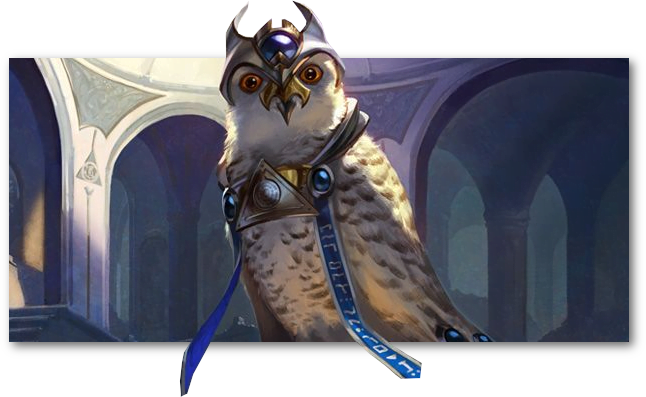
MTG: Tapping Out
I’m not going to write regularly about Magic: the Gathering this year.
There are a few reasons for it, but the basic one is that it’s neither easy nor fun any more.
When I started writing articles about Magic: The Gathering the plan was that since I was playing Standard, Modern and Commander, I’d just post the deck I played that week, give it a little twist, and move on, or maybe talk about new sets when they came out. This would build on my old work on Starcity Games under the heading Tact or Friction. I think about that column from time to time – a year spent writing, for money, about Magic to an audience of thousands. I think about it because I think it was such a colossal, embarassing waste.
I wanted, in my heart of hearts, to make the kind of content that FNM-fan Magic players could enjoy. Things that could help the new players step up, avoid the pitfalls of chasing expensive junk rares. I thought I could talk to the design of the game (and in many ways, I was right, a fact I hold to my heart as tight as I can in these moments of despair), and I wanted to try and make the game better and more fun in the ways that I thought it could be. And as justified as I was, I’ll still always be that guy who submitted a spiteful, angry ill-thought out screed and it got paid for.
I know I could do better now.
I wanted to work on Magic: The Gathering content, which has three basic forms that are easy to work with, using my new direction of not being a total asshole. First, there’s talking about a deck, or a deck piece. The second is responding to new releases, doing things like set reviews. The third is to respond to current events, things like big public events, like when I wrote about the data release problem two years ago.
Well, the big events thing ran into a problem in that there wasn’t a lot of happy news around Magic: The Gathering to respond to. People I liked left the company, which was a bummer. The story went directions I didn’t enjoy. There was a boycott of worlds, moments of commentators being total dicks about things, at least one sexual harrassment scandal, and the classic reddit spiral of ‘jackasses saying the same wrong stuff about the game.’ There was an endless maw of news, but it was always spiteful, and tired, and ignorant.
As far as releases go, they were dreadfully uninspiring. I literally forgot to do a set review for Hour of Devastation, back in 2017 and my review of Ixalan was so negative that I actually revised it to be nicer to the set because I know people worked hard on it. I just skipped the set reviews since – I found myself not wanting to say much that was nice about Rivals of Ixalan, which reflected in my ‘set review.’ I barely bothered for the remaining sets of the year – Core Set 2019, I mean jeeze.
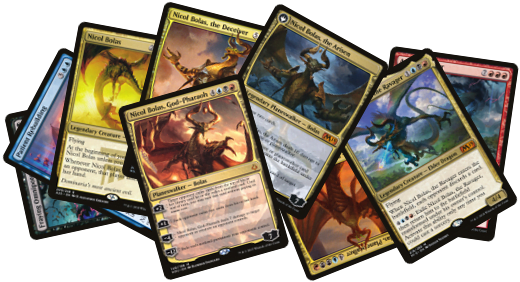
Oh, and of course, there’s the importance of Nicol Bolas. I don’t care about Nicol Bolas, I don’t like Nicol Bolas. He’s not a compelling villain (to me), and the way he’s brought in to be behind everything feels like a DM’s pet NPC (to me). He’s had something like six cards in the past two years and every time we get a New, Different Nicol Bolas, he’s eating the space that could be used by something I care about. We could be exploring new mysteries or building new villains or just dealing with something other than more of Nicol Bolas’ plans, but seems that no. No, it’s much better that we keep going back to the well of an omnipresent, eternally important character whose defining trait is well I already thought of that like you’re playing lets-pretend with a little kid.
Over the course of the last year, Standard has been an environment about waiting for it to change. Dominaria was full of promise, but mostly spent its time reminding me how bad Magic used to be. Ixalan promised an exciting new place and insight into Vraska, but no, that’s just another Bolas plot. Guilds of Ravnica promised to return to beloved guilds and plane, but no, turns out that’s also a Bolas plot and also the guilds I liked look awful.
The past two years of Magic: The Gathering have been very much Not For Me, even as I appreciate and am glad to see the new technological developments and improvements the designers have had access to. I genuinely find that exciting. But the environments they’re creating and the ensuing play experience has just not appealed to me, and it has slowly but steadily driven the kind of content I can make, leading to things like the pet cards (which I really liked doing) and the Kamigawa revamp (which was fun, but exhausting).
I’m going to keep playing the game. It’s still a great game. But it’s a game I don’t want to play every week. It’s not a game whose content churn is pleasing to me, nor do I want to be part of.
MTG: Kamigawa Revamp, Part 5: Betrayers of Kamigawa
Wizards of the Coast Employees, this article is going to feature custom card designs.
Goodness me, this project took some time. The opening documents you’ve read so far have all been done, weeks, no, almost months in advance, but as I sit here and pen this, it’s only two weeks before it goes up – and my goodness it has been a time to get this project finished.
First, let’s introduce you to the cards, and then we’ll talk some afterwards.
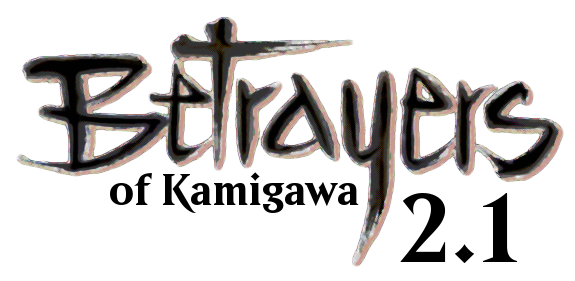
MTG: Kamigawa Revamp, Part 4: Skeletonising
If you thought the last two discussions on structural problems was exciting, wait till you see what we got this time – lists!
In Nuts and Bolts: Design Skeleton, Mark Rosewater gives an – admittedly out of date – block structure, which we can use for our two Kamigawa sets. Or more precisely, we can use it to break down how to make a skeleton out of Dominaria. It gives an outline for how many cards of each effect you should be expecting to put in a set,
Continue Reading →MTG: Kamigawa Revamp, Part 3: Legendary
Wizards of the Coast Employees, this article is going to feature custom card designs.
We’ve talked about the structural problems of Kamigawa 1.0, but just to recap, the whole set is about six conflicting factions – five mono-coloured groups against the five-coloured omnishambles that is the Spirit faction. With that problem ‘examined’ last time, it’s time to attack the next structural problem: Legendary.
Now, when I examined Kamigawa from the ground up, there’s a bunch of stuff in the set that works out well. Bushido is a good little combat complicator, even if cards printed with it overvalued it, making them mostly only valuable or meaningful within the context of limited creature combat. The flip cards and ninjutsu both work. Yet legendary, as represented on cards, presents two problems.
Continue Reading →MTG: Kamigawa Revamp, Part 2: The Kami War
Wizards of the Coast Employees, this article is going to feature custom card designs.
When you want to dismantle a set and fix it, it seems to me you should want to get down as close as possible to the basics of what went into that set. Strip it down, examine the central principles, and see what you can do to fix them. You need to find the things that made the set feel the way it did without, hopefully, carrying forwards the things that made it feel bad. Which means that you want to represent the same general factional struggle and strife, you want things to broadly still have the same boxes they can land in and in Kamigawa that means addressing the big flavour underpinning the whole thing:
The Kami War.
Continue Reading →MTG: Kamigawa Revamp, Part 1: First Principles
This is an article that discusses custom set design but does not show any custom designed cards.
Continue Reading →MTG: Pet Cards XIX, Amonkhet Block
I guess… this is the end?
The most recent set to cycle out, the most recent set I can think of as having ‘gone’ from Standard. A set I played a lot, with my fistful of change, a set I watched streamers drafting. A set that I really did like.
I might go back and look at Odyssey block again, because, I mean surely I should? But I’m going to enjoy digging into Amonkhet in the coming weeks, to play with it out of standard, to see what casual modern feels like in the MTGO playrooms.
MTG: Karador and the Decisive Combo
Some Commanders create a robust structure around them, a sort of general-purpose space where you can use them to construct a solid but not unreasonable deck. Sometimes a Commander is a back-up plan, who can come in to bat clean-up after your deck has done its thing. Sometimes a commander enables a slow, grinding playstyle and sometimes they are the sword which you plunge into other players’ hearts.
Maybe we’ll talk about some of those soon.
Anyway, one of my favourite Commanders, a commander who helped really crystallise me as a Commander player on MTGO, is [mtg_card]Karador, Ghost Chieftain[/mtg_card].
I may just be a sucker for playing dudes with antlers.